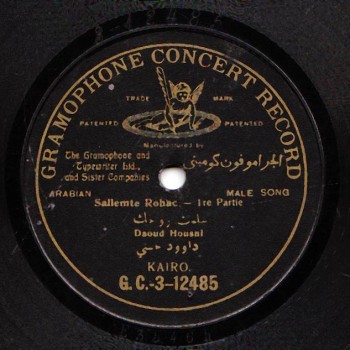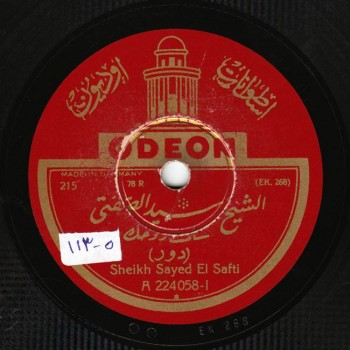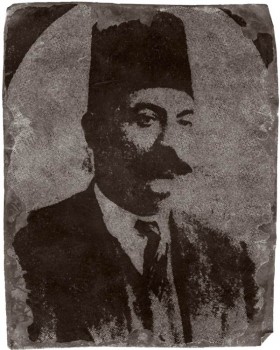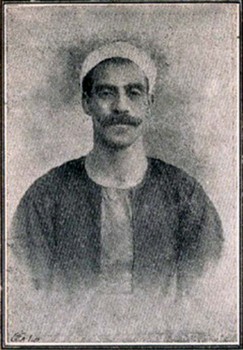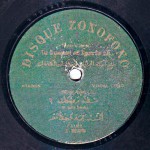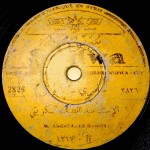The Arab Music Archiving and Research foundation (AMAR), in collaboration with the Sharjah Art Foundation (SAF), presents “Sama‘ ”.
“Sama‘ ” is a show that discusses our musical heritage through comparison and analysis…
A concept by Mustafa Said.
Dear listeners, welcome to a new episode of “Sama‘ ”.
Today, we will be analysing dawr “Sallimti rūḥak” written by Sheikh Aḥmad ‘Āshūr, and composed by Dāwūd Ḥusnī allegedly in the late 19th century, i.e. before the recording era.
This dawr was recorded many times by numerous artists with different record companies, and was apparently among the well-liked and famous dawr in the early 20th century. Those who recorded it include: Sheikh Yūsuf al-Manyalāwī –once with Sama‘ al-Mulūk, and once with Gramophone; ‘Abd al-Ḥayy Ḥilmī –once with Odeon and once with Zonophone at least, he may have recorded it a third time with Baidaphon; Sayyid al-Safṭī –once with Gramophone, once with Baidaphon, and once with Odeon; Dāwūd Ḥusnī himself –with Gramophone; Bamba the ‘ūdist, Asma al-Kumthariyya among many others; and later generations including ‘Alī ‘Abd al-Bārī, Maḥmūd al-Bulāqī and Ibrāhīm Shafīq…
Here are the lyrics of the dawr:
Madhhab:
Sallimti rūḥak yā fu’ādī li-el-gharām min ghēr mā ti‘lam
We-ṣabaḥt ‘urḍa li-el-hawān w-el-malām khāyif la-ti‘dam yā albī
Ti‘raf khalāṣak
Dawr:
El-amri amrak mush āyillak min zamān shūf el-adilla rūḥī fī īdak wahabtihālak
Bass el-amān min dī el-madhalla
Dāwūd Ḥusnī composed this dawr to the shūrī maqām, a sub-maqām of the dūkāh or the bayyātī, where the bayyātī aspect is linked to the ḥijāz’s fourth scale position: a bayyātī aspect is followed by a ḥijāz aspect.
The shūrī’s pattern is different from the Turkish karjaghār –more widely used in Turkey–, the karjaghār being the maqām of dawr such as Sayyid Darwīsh’s “Dayya‘t musta’bal ḥayātī”.
The karjaghār starts from the top… ♩
…whereas the shūrī follows the bayyātī’s pattern and uses a ḥijāz sub-maqām… ♩
…Besides the change of the sub-maqām’s aspect to a ḥijāz aspect, the karjaghār’s pattern is quite similar to the bayyātī’s.
Let us start with the madhhab.
We are lucky to have in our possession Gramophone’s recording of this dawr performed by its composer Afandī Dāwūd Ḥusnī himself during the record company’s second recording campaign –that may have taken place in winter 1904– on both sides of a 25cm record. Let us listen to the madhhab performed by Dāwūd Ḥusnī.
(♩)
Beautiful! He started in a usual manner: as if to the bayyātī, then took the ḥijāz aspect and followed the shūrī’s pattern.
In his book “Al-mūsīqī al-sharqī”, Kāmil al-Khula‘ī wrote that dawr “Sallimti rūḥak” must be performed to the shūrī or to the ṣabā. But I never heard it recorded to the ṣabā. So let us stay with the known version to the shūrī.
(♩)
We have listened to the madhhab performed by Dāwūd Ḥusnī, whose melody must be the original one.
Here are two short remarks:
First, the takht is of an unusual type with regards to early 20th century recordings. It includes Dāwūd Ḥusnī (‘ūd), probably ‘Alī ‘Abduh Ṣāliḥ (nāy), percussionist unknown, and two or three biṭāna members.
Second, the unknown percussionist is playing ‘ala al-waḥda, not to the maṣmūdī as written in almost all heritage books: that all dawr madhhab must be played to the maṣmūdī, i.e. 8/4.
If the man is playing ‘ala al-waḥda, i.e. 4/4, then Dāwūd Ḥusnī must have wanted this: as the composer of the dawr, he simply had to tell the percussionist to play to the maṣmūdī. But it seems that he meant to play the madhhab to the waḥda.
This shows the chasm between what is written in books and the reality of live performances, added to the theory establishing that a dawr should be sung to the shūrī and to the ṣabā.
Let us listen to the same madhhab performed by mashaykhī Sheikh Yūsuf al-Manyalāwī and note the differences between his performance and Dāwūd Afandī Ḥusnī’s.
The focus of this analysis is the style of the performance, not Dāwūd Afandī Ḥusnī being its composer:
Dāwūd Ḥusnī sings the tune and plays it on the ‘ūd in an almost fixed manner, along with those accompanying him. There are almost no variations except for the ornamentations all muṭrib usually add to the melody.
Whereas Sheikh Yūsuf –whom we will listen to right now– has the biṭāna sing the melody of the dawr while he adds variations as if he were dealing with a tawshīḥ for example.
(♩)
Beautiful, Sheikh Yūsuf! This was one of the differences between a mashaykhī’s performance and an afandī’s performance of the same tune.
Now let us listen to the madhhab performed by ‘Abd al-Ḥayy Afandī Ḥilmī who, despite being an afandī, did not abide by melodies. He saw the melody as a canvas that he dealt with according to his personal point of view, whether this melody was fixed like the madhhab, or a tafrīd like the dawr. ‘Abd al-Ḥayy Ḥilmī decides either to drop a certain section of a dawr, or to extend a certain section, such as another maqām of the dawr that is supposed be an ornamentation, but that he extends to the entire duration of the record-side. He even deals with the madhhab from his personal point of view. He does not drop the melody completely, he still abides by it… or why would he sing the dawr to start with? Still, there is always a personal initiative that goes beyond one note, far away from the original pattern of the melody.
Let us listen to the madhhab performed by ‘Abd al-Ḥayy Afandī Ḥilmī.
(♩)
Let us now listen to two recordings of the madhhab performed by Sheikh Sayyid al-Safṭī:
The first recording was made by Baidaphon around 1909.
The second recording was made by Odeon around 1928.
…1909 with Baidaphon, and in 1928 with Odeon, i.e. a 19 years’ gap between both recordings. Note how he dealt with the dawr in 1909 then how he dealt with it in 1928.
(♩)
Baidaphon’s 1909 recording includes very little changes, except for some acrobatics and entertainment elements v/s the expertise/experience and stability in Odeon’s 1928 recording. The melody is the same, with only a few added light ornamentations. He did not follow ‘Abd al-Ḥayy Ḥilmī’s example or Sheikh Yūsuf’s, and stayed closer to Dāwūd Ḥusnī’s despite being a Sheikh, abiding by the melody and the pattern etc.. Yet there are differences resulting from his experience, the difference between a man in his forties and a man in his sixties.
Of course, this shows that music is not only related to a situation or an event, but also to time and to the person’s age. Music professionals look at melody and music differently depending on their age. And as much as they may be loyal to a certain type or a certain form, the way they think changes from one age to another, even with regards to the same piece.
There’s an anecdote concerning dawr “Sallimti rūḥak”:
Every sung melody can usually be played with one instrument or more, and can become a purely instrumental piece. Yet, some songs more than others are compatible with instruments and seem to be initially purely instrumental works, such as dawr “Sallimti rūḥak” that in my opinion fits this profile perfectly. So, two or three years ago I decided to play it in one concert or more, but we discovered a few months ago a recorded instrumental version played by the violinist who accompanied the majority of the muṭrib we listened to. I am referring to Sāmī al-Shawwā who played it towards the end of his life in the 1960’s, possibly during the commemoration ceremony dedicated to Ṣāliḥ ‘Abd al-Ḥayy.
Let us listen to the purely instrumental recording of the dawr.
(♩)
Beautiful Sī Sāmī!
Moreover, his performance in this recording is unlike his other recordings where he translates the singing. He is playing solo on the kamān without percussions, a takht, or anything else. Despite this, the interpretation of the singing by the instrument was not at all affected by the lack of percussions or of the other instruments. He interpreted all the lyrics of the dawr with his instrument, as if the violin were singing them.
Here is another call… We had already made a call to all music professionals: People! Our music is built on a language basis not on a mathematical basis. Those who wish to own their instrument must be good at interpreting songs on them. Playing a taqsīm includes the segmentation of metrical sections. In order to excel at this Classical Arabic Art, one had better train on interpreting the singing with the instrument, which will result in very different taqsīm. You will remember what I am telling you.
Before concluding this episode, let us listen to the type version of this dawr, as envisioned and performed by Dāwūd Ḥusnī.
Of course, he could put his vision aside when the dawr was performed by Sheikh Yūsuf al-Manyalāwī for example. I do no think Dāwūd Ḥusnī took offence when Sheikh Yūsuf, ‘Abd al-Ḥayy Ḥilmī, or any other performed it. At the time, intellectual property did not exist. One did not take offence if another changed his work. Anyway, this did not actually change anything.
On the other hand, it is said that Muḥammad ‘Uthmān was offended when he heard the brass instruments band playing dawr “Kādni el-hawa” because he did not like the way they were playing it, i.e. in a military manner as if it were a “marche”.
Let us listen to Sayyid al-Safṭī’s version of dawr “Sallimti rūḥak”, made by Odeon on an electrical-power printed record around 1928. He is accompanied by Sāmī al-Shawwā (kamān), ‘Abd al-Ḥamīd al-Quḍḍābī (qānūn) and Maḥmūd Raḥmī (percussions). The way the four instrumentalists deal together in their accompaniment of this performance of the dawr reveals their experience of many years in playing together. Sayyid al-Safṭī’s voice sounds old, yet the recording also shows his incredible experience and performance –even though brief. He was so moved that he even cried.
Let us listen to dawr “Sallimti rūḥak” written by Sheikh Aḥmad ‘Āshūr and composed by Dāwūd Ḥusnī, performed by Sheikh Sayyid al-Safṭī.
(♩)
We have reached the end of today’s episode.
We will resume our analysis of dawr “Sallimti rūḥak” in our future episode of “Sama‘ ”.
“Sama‘ ” is brought to you by AMAR.
- 221 – Zakariyya Ahmed – 12 (1/9/2022)
- 220 – Zakariyya Ahmed – 11 (1/9/2022)
- 219 – Zakariyya Ahmed – 10 (11/25/2021)
- 218 – Zakariyya Ahmed – 9 (10/26/2021)
- 217 – Zakariyya Ahmed – 8 (9/24/2021)
- 216 – Zakariyya Ahmed – 7 (9/4/2021)
- 215 – Zakariyya Ahmed – 6 (8/28/2021)
- 214 – Zakariyya Ahmed – 5 (8/6/2021)
- 213 – Zakariyya Ahmed – 4 (6/26/2021)
- 212 – Zakariyya Ahmed – 3 (5/27/2021)
- 211 – Zakariyya Ahmed – 2 (5/1/2021)
- 210 – Zakariyya Ahmed – 1 (4/28/2021)
- 209 – W-al-Lāhi lā astaṭī‘u ṣaddak 2 (4/6/2017)
- 208 – W-al-Lāhi lā astaṭī‘u ṣaddak 1 (3/30/2017)
- 207 – Bashraf qarah baṭāq 7 (3/23/2017)

